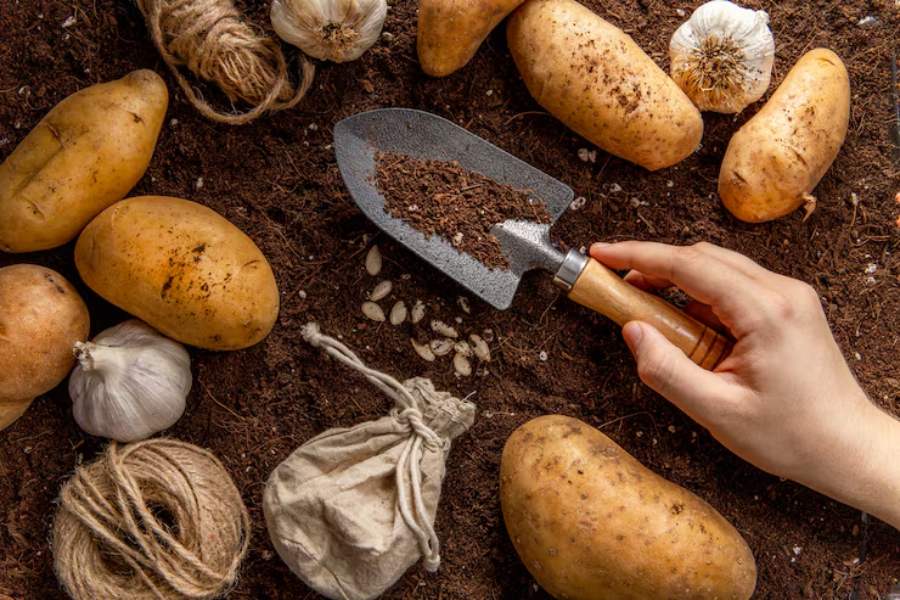
When do you plant potatoes? The answer varies with soil, climate, and season. Potatoes are rewarding to grow, but success depends on planting at the right time. Too early, and frost can wipe out seed tubers. Too late, and rising heat may limit yields.
These crops thrive in cool weather, which is why many gardeners plant two to three weeks before the last frost. In mild-winter regions, potatoes can also be sown in late fall for an early spring harvest. Soil temperature is just as important as dates—ideally between 45–55°F, a range that prevents rotting and encourages sprouting.
This guide explores not only when do you plant potatoes but also how timing, local conditions, and planting methods affect strong, productive crops.
When do you plant potatoes?
Plant potatoes two to three weeks before the last frost, when soil is 45–55°F. In warmer regions, they can also go in during late fall for a spring harvest.
When Do You Plant Potatoes in Different Seasons?
When do you plant potatoes depends largely on the season and local climate. Most gardeners favor early spring, sowing seed potatoes two to three weeks before the last frost date. At this point, the soil begins to warm while remaining cool enough to support healthy tuber sprouting.
Soil temperature is critical, ideally ranging between 45–55°F. At this level, tubers avoid rotting in cold, wet ground but still germinate before summer heat arrives. Planting too early risks frost damage, while planting too late can shorten the growing season and reduce yields.
Late-season planting is another option. In regions with long summers, potatoes can be planted again mid to late summer for a fall harvest. These crops mature before the first hard frost.
In mild or frost-free climates, potatoes may even be planted during winter. This allows gardeners to harvest in early spring, taking advantage of cool conditions before warmer months arrive.
Why Does Timing Matter for Potato Planting?
Timing plays a central role in potato production, directly shaping sprouting, growth, and eventual yields. Planting too early risks frost damage, while waiting too long can shorten the season and reduce harvest size.
When Do You Plant Potatoes for Spring Crops?
Spring is the prime planting season. Potatoes are best sown two to three weeks before the last frost, giving them cool soil to sprout safely.
How Soil Temperature Influences Planting Time
Soil between 45–55°F is ideal. Colder ground may cause rot, while warmer soil can hinder sprout development. A soil thermometer is more reliable than dates alone.
Why Frost Dates Are Critical
Frost kills young shoots. Tracking your region’s last frost ensures planting aligns with a safe growing window.
When Do You Plant Potatoes in Containers?
Containers warm faster than garden beds. Once potting soil reaches 45°F, potatoes can be planted earlier, extending the growing season.
How to Decide the Right Time to Plant Potatoes?
Knowing when do you plant potatoes, as outlined by Pedro Vaz Paulo, comes down to combining climate, soil conditions, and variety choice. Instead of relying only on the calendar, gardeners should use practical tools and local cues to set the right schedule for planting.
Check USDA Growing Zone Charts
Your zone defines the average frost dates and seasonal length, guiding the best planting window.
Track Frost Dates in Your Region
Plant two to three weeks before the last frost, but always keep local weather in mind.
Use a Soil Thermometer
Soil between 45–55°F ensures tubers sprout without rotting or overheating.
Adjust for Varieties
Early potatoes need a head start, while late varieties can handle later planting.
Try Raised Beds or Containers
These warm faster than ground soil, allowing earlier planting.
Follow Local Farming Calendars
Community schedules often reflect tried-and-true planting times.
When Do You Plant Potatoes by Climate Zone?
The answer to when do you plant potatoes varies widely by climate. In northern regions with harsh winters, planting is delayed until late April or May, once the soil thaws and warms above 45°F. This timing protects tubers from frost damage and ensures healthy sprouting.
In the South, planting can start as early as February or March. Mild winters allow potatoes to establish before summer heat arrives, which helps prevent smaller yields. Coastal climates add even more flexibility. Thanks to moderate ocean temperatures, gardeners in these areas often enjoy two planting windows—spring and fall.
High-altitude zones are the most restrictive. Cold nights and short seasons delay planting until late spring. Gardeners here typically choose fast-maturing varieties to secure a harvest before early fall frosts return, maximizing their limited growing window.
The Big Question – When Do You Plant Potatoes for Best Yield?
Planting time directly affects potato size, flavor, and storage life. Knowing when to plant early, mid-season, or late varieties helps maximize yield and quality.
When to Plant Early Varieties
Early potato varieties thrive when planted two to three weeks before the last frost. They sprout quickly in cool soil and produce “new potatoes” ready for harvest in about 70–90 days. These are perfect for gardeners wanting an early summer crop.
When to Plant Mid-Season Varieties
Mid-season types are usually planted around the same time but take longer to mature, about 100–110 days. They benefit from stable spring temperatures and provide larger yields by mid to late summer.
When to Plant Late Varieties
Late potatoes require the longest growing season, often 110–135 days. They are best planted after the soil has fully warmed but before intense summer heat arrives. These varieties are ideal for storage, offering hearty harvests that last through winter if timed correctly.
What Factors Influence When You Plant Potatoes?
Deciding when do you plant potatoes depends on several factors that directly affect growth and yield. Each plays a role in ensuring tubers sprout, mature, and produce a healthy harvest.
Climate Zone: Regional climate sets the growing calendar. Northern areas usually plant in late April or May, while southern regions may begin as early as February.
Soil Temperature: Potatoes sprout best when the soil is 45–55°F. Anything colder risks rot, while hotter conditions can weaken tuber growth.
Moisture Levels: Balanced moisture is essential. Excess water encourages rot, while overly dry soil delays sprouting. Consistent watering supports steady development.
Sunlight Hours: Potatoes need at least six hours of full sun daily. Long summer days promote growth but can shorten the cool-weather window.
Variety Choice and Method: Early varieties tolerate cooler soil, while late types need longer seasons. Raised beds and containers warm quickly, allowing earlier planting.
How Can Gardeners Plan Their Planting Calendar?
A well-planned planting calendar helps gardeners avoid frost damage, rotate crops effectively, and achieve consistent harvests. By organizing dates and methods in advance, growing potatoes becomes a strategic process rather than guesswork.
Mark Frost Dates: Frost is the greatest danger to young potato shoots. Track the last frost in spring and the first frost in fall to define safe planting and harvest windows.
Plan Crop Rotation: Planting potatoes in the same soil every year invites pests and disease. Rotate with legumes, leafy greens, or grains to restore nutrients and protect the soil.
Align with Harvest Goals: Tailor planting to your needs. Early sowing provides tender new potatoes in summer, while later planting produces larger storage crops for winter use.
Use Gardening Apps/Calendars: Digital tools simplify planning by sending reminders about frost dates, planting windows, and harvest times, keeping even beginners organized.
Final Thought
The question when do you plant potatoes is about more than picking a date—it’s about aligning nature, soil, and season for the best harvest. Successful potato growing depends on understanding frost windows, soil temperature, and the unique demands of each variety. By planning carefully, gardeners can avoid common pitfalls like frost damage or heat stress while maximizing yields. Whether you aim for early new potatoes, mid-season crops, or hearty late varieties for storage, timing remains the key factor. With tools like frost charts, soil thermometers, and gardening calendars, planting becomes less of a gamble and more of a strategy. A thoughtful approach ensures each season delivers healthy plants and abundant potatoes.
FAQ’s
When do you plant potatoes in spring?
Plant them two to three weeks before the last frost date, once the soil has warmed to at least 45°F.
Can I plant potatoes in the fall?
Yes, in mild climates, fall planting allows potatoes to grow through winter and be harvested in early spring.
When do you plant potatoes in containers?
Potatoes can be planted in containers as soon as soil temperatures reach 45–55°F, often earlier than in open ground.
What month do most people plant potatoes?
Most gardeners plant between March and May, though southern regions often begin in February.
When do you plant potatoes for storage harvests?
Late spring plantings produce full-size potatoes ready for harvesting and storing through the fall and winter.








